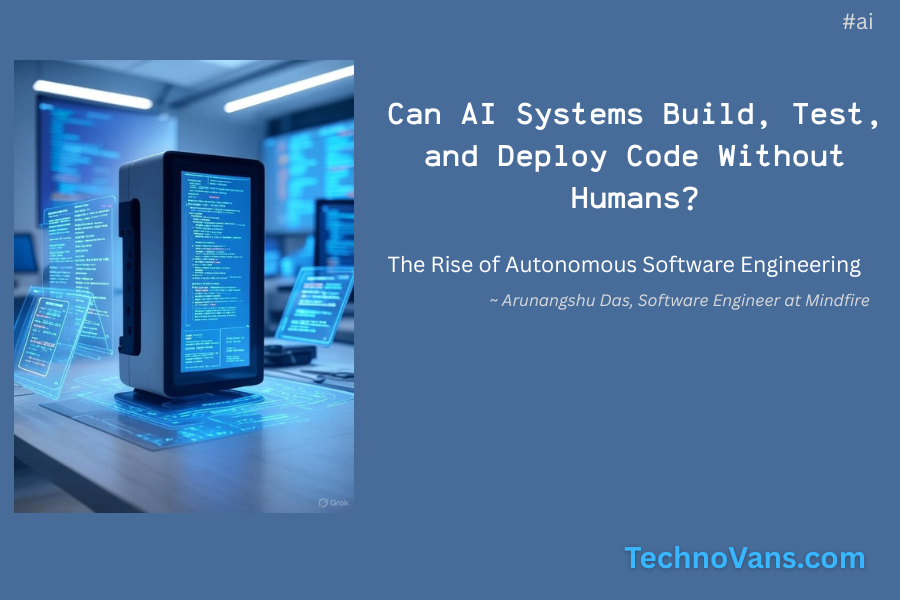Can AI Systems Build, Test, and Deploy Code Without Humans?
The Rise of Autonomous Software Engineering
– Arunangshu Das, Software Engineer at Mindfire

Just a few years ago, the idea that AI could handle the complete software development lifecycle — from building to testing to deployment — seemed more like an overambitious dream than an achievable reality.
Today, it’s no longer a question of if AI can build software independently.
It’s a question of how far and how fast it will reshape the very foundations of software engineering.
How AI Is Learning to Build Code — Not Just Generate It
Tools like OpenAI’s Codex, Meta’s Code Llama, and Google’s AlphaCode have redefined what’s possible with code generation.
These models don’t just autocomplete functions or suggest snippets anymore — they can architect entire backend systems, design RESTful APIs, scaffold frontend applications, and write domain-specific algorithms based on minimal prompts.
For example, a developer today can input:
“Build a microservice for processing payment transactions, with validation, error handling, and retry mechanisms.”
And within minutes, an AI agent can generate a production-grade service in Node.js, complete with API documentation, schema validation, integration tests, and Dockerfile configurations.
It’s not just code generation anymore — it’s autonomous software engineering.
Testing at Machine Speed
Testing, once the painstaking bottleneck of every development cycle, is undergoing a similar transformation.
Modern AI systems can:
- Automatically generate unit, integration, and end-to-end test suites,
- Predict likely failure points using static analysis,
- Simulate real-world usage scenarios based on synthetic user behavior modeling,
- Perform regression testing at every code commit without waiting for human QA.
Frameworks are emerging where AI agents not only write the tests but interpret the results, refactor code, and even rewrite failing test cases — often before a human even logs into the repository.
With machine-driven feedback loops, the software is not just tested faster — it’s tested smarter.
Deployment: One Push, No Panic
Deployment, the traditional “danger zone” for software teams, is becoming safer and more streamlined through AI orchestration.
Using integrations with CI/CD tools like GitHub Actions, AWS CodePipeline, and Kubernetes operators, AI-driven systems can:
- Detect when code is ready for production,
- Create optimized build artifacts,
- Manage infrastructure as code (IaC) for cloud-native deployments,
- Trigger canary releases, blue-green deployments, and even monitor live telemetry post-launch.
Some AI models are even trained to auto-scale cloud resources based on projected traffic patterns, ensuring both performance and cost-efficiency — without human intervention.
In essence, AI is learning not just to ship code, but to operate software ecosystems autonomously.
Where the Line Blurs — And Why Humans Still Matter
Despite the remarkable progress, AI today has critical limitations:
- Contextual Reasoning: AI struggles with deep domain knowledge, regulatory compliance needs, and complex business logic that often require human judgment.
- Security Awareness: While AI can spot known vulnerabilities, it can also inadvertently introduce new attack surfaces — especially when operating in dynamic, multi-cloud environments.
- Ethical Decision-Making: AI cannot yet distinguish between a feature that is technically viable and one that is socially irresponsible, biased, or harmful.
This is why the best future isn’t fully autonomous development — it’s augmented development.
The industry is moving toward a “Human-in-the-Loop” (HITL) model:
AI handles 80–90% of the mechanical, repetitive work, while humans focus on architecture, governance, ethical reviews, and innovation.
Or, to put it simply:
Machines can build. Humans must lead.
The Broader Impact: What This Means for the Industry
If autonomous software development matures (and all signs suggest it will), the ripple effects could be massive:
- Startups: Founders could launch full SaaS platforms with minimal engineering headcount.
- Enterprises: Legacy modernization could accelerate, reducing multi-year projects to months.
- Emerging Economies: Access to sophisticated digital products would no longer be bottlenecked by local developer shortages.
- Open Source: AIs could maintain and evolve open-source projects at a scale never seen before.
In short, AI could democratize software creation — putting powerful tools in the hands of individuals and small teams, not just tech giants.
A New Kind of Software Developer
As this shift accelerates, the definition of a “developer” will evolve.
Tomorrow’s engineers won’t just write code — they’ll design prompts, orchestrate AI workflows, audit machine output, and steer digital ecosystems toward safe and meaningful outcomes.
This isn’t the end of software development.
It’s the birth of AI-assisted software architecture — a new discipline where creativity, responsibility, and technology collide.
Final Thought: The Co-Authorship Era Has Begun
We are witnessing the start of a historic partnership:
Humans bring context, empathy, and wisdom.
Machines bring speed, scale, and relentless execution.
The future of software won’t be written by humans alone — and it won’t be written by AI alone either.
It will be co-authored.
And if we do it right, it will be a masterpiece.



